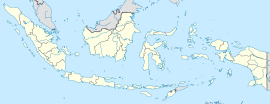 A view of Gunung Padang | |
 | |
| Location | Karyamukti, West Java, Indonesia |
|---|---|
| Coordinates | 6°59′38″S 107°03′23″E / 6.99389°S 107.05639°E |
| Type | Megalith |
| Site notes | |
| Discovered | 1890 |
| Archaeologists |
|
Gunung Padang is an archaeological site located in Karyamukti, West Java, Indonesia, 50 kilometres (31 mi) southwest of Cianjur. Located at 885 metres (2,904 ft) above sea level, the site covers a hill—an extinct volcano—in a series of five terraces bordered by retaining walls of stone that are accessed by 370 successive andesite steps rising about 95 metres (312 ft). It is covered with massive hexagonal stone columns of volcanic origin.[1] The Sundanese people consider the site sacred and believe it was the result of King Siliwangi's attempt to build a palace in one night.[2]
Gunung Padang consists of a series of five artificial terraces, one rectangular and four trapezoidal, that occur, one through five, at successively higher elevations. These terraces also become successively smaller with elevation, with the first terrace as the lowest and largest and the fifth terrace as the highest and smallest. These terraces lie along a central, longitudinal NW–SE axis. They are artificial platforms created by lowering high spots and filling in low spots with fill until a flat surface was achieved. The terrace perimeters consist of retaining walls formed by volcanic polygonal columns stacked horizontally and built vertically as posts. The terrace complex is accessed by a central stairway with 370 steps, an inclination of 45 degrees, and a length of 110 m (360 ft).[2][3]
- ^ Ramadina, Savitri Putri (2013). "Analisis Perupaan Situs Megalitik Gunung Padang di Cianjur, Jawa Barat" [Sculpture Analysis of the Megalithic Site of Gunung Padang in Cianjur, West Java]. ITB Journal of Visual Art and Design. 4 (1): 51–66. doi:10.5614/itbj.vad.2013.4.1.7.
- ^ a b Cite error: The named reference
Garciawas invoked but never defined (see the help page). - ^ Yondri, Lufti (2014). "Punden Berundak Gunung Padang Refleksi Adaptasi Lingkungan dari Masyarakat Megalitik" [Punden Berundak Gunung Padang Reflection of Environmental Adaptation from Megalithic Society]. Jurnal Sosioteknologi. 13 (1): 1–14. doi:10.5614/sostek.itbj.2014.13.1.1.
